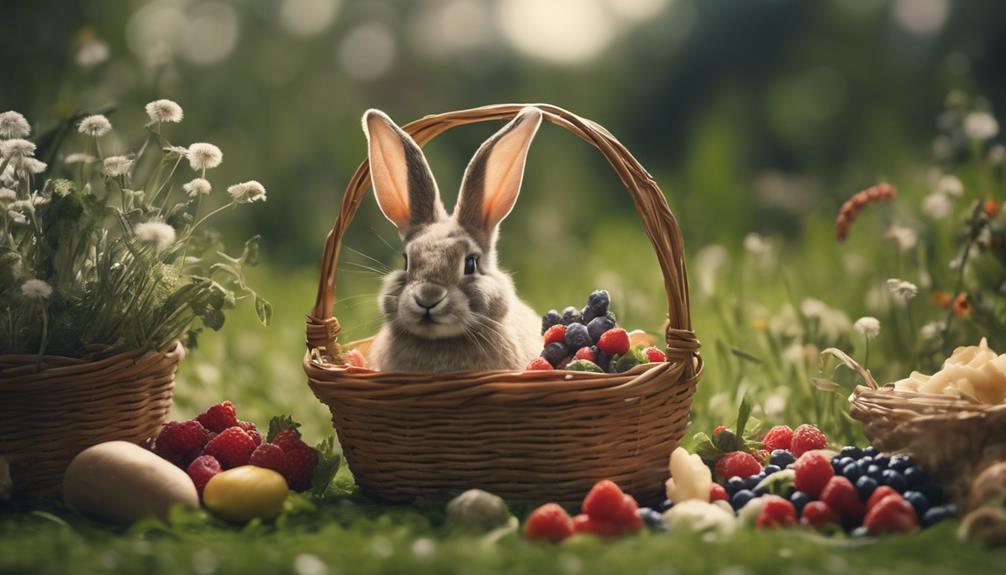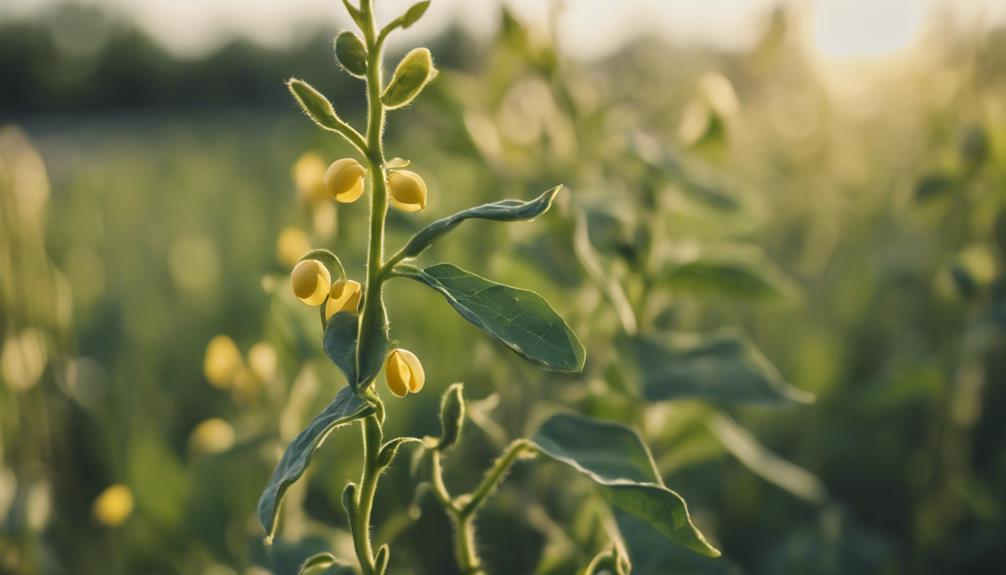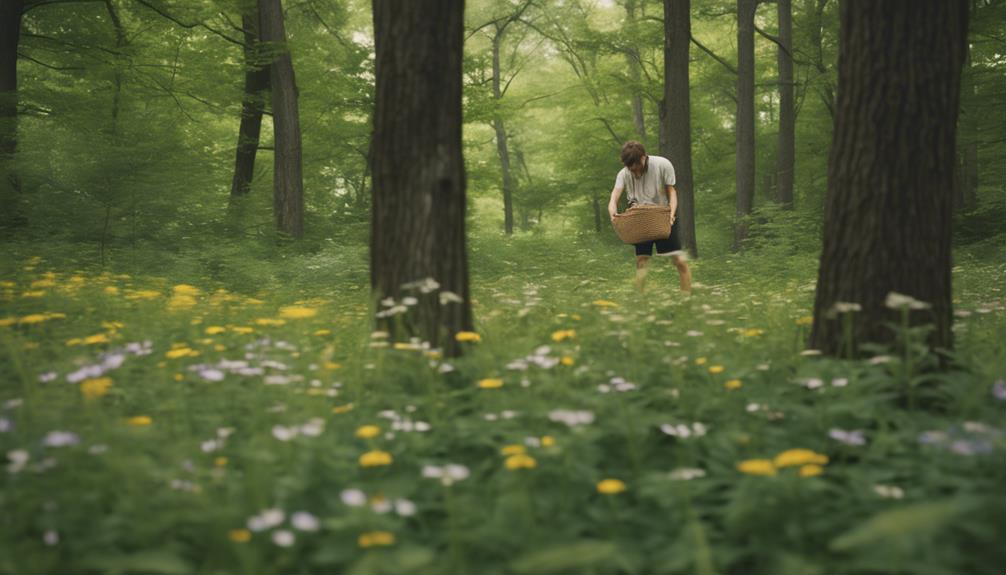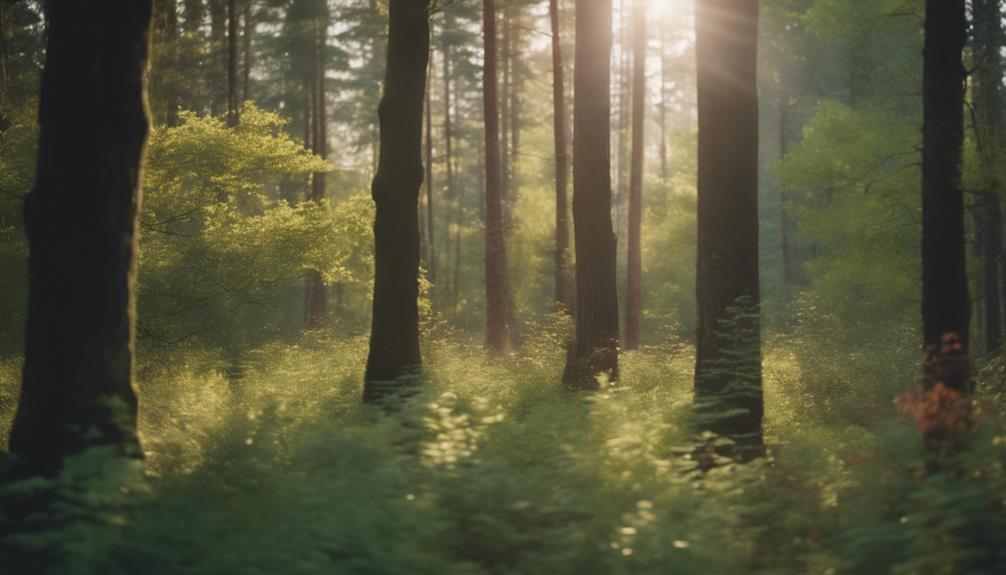You can forage for a variety of nutrient-rich plants to provide your rabbit with a diverse and engaging diet that mimics their wild ancestors' feeding habits. Safe foraging practices, like identifying edible plants and avoiding polluted areas, are essential. Dandelions, plantain, and calendula are all healthy options that provide fiber, vitamins, and nutrients. Introduce new treats gradually and in moderation to prevent stomach upset. By foraging responsibly, you can provide your rabbit with a more natural and cost-effective diet. Explore the world of foraging further to discover more nutritious treats for your furry friend. Additionally, many of the same plants suitable for rabbits can also be enjoyed by other small animals. For example, foraging safe foods for guinea pigs, such as fresh grasses and certain herbs, can also enhance their diet and overall well-being. Always research the specific dietary needs of your pet to ensure the plants you forage are both nutritious and safe for consumption.
Key Takeaways
- Forage for wild greens like dandelion and plantain to provide a diverse and nutritious diet for your rabbit.
- Identify edible plants by their characteristics and wear gloves when handling plants like stinging nettle.
- Introduce new foraged treats gradually to prevent digestive upset and monitor your rabbit's reaction to new foods.
- Avoid foraging in areas contaminated with pollution, pesticides, or chemicals, and wash plants thoroughly before feeding.
- Start with small amounts of new treats and introduce one plant at a time to ensure your rabbit can tolerate them.
Why Forage for Rabbit Treats
By foraging for natural treats, you can provide your rabbit with a diverse and nutritious diet that mirrors their wild ancestors' feeding habits. This approach allows you to offer a more natural feeding experience, which rabbits love.
By mimicking their wild diet, you're providing essential nutrients and fiber that are crucial for their overall health. Foraging for rabbit treats reduces your reliance on commercial pellets and adds variety to their meals. It's also a cost-effective way to feed your rabbit, and the process itself can be a fun and engaging experience for you and your pet.
Additionally, certain wild plants have medicinal properties that can benefit your rabbit's health. By embracing foraging, you're promoting sustainable feeding practices that bring you and your rabbit closer to nature.
Safe Foraging Practices

As you start foraging for natural treats for your rabbit, prioritizing safe practices is crucial to guarantee the health and well-being of your pet.
You'll need to identify edible plants, know your environment, and be aware of pests to avoid any potential risks.
Identify Edible Plants
When foraging for edible plants, start by recognizing characteristics like serrated leaves, distinct flowers, and growth patterns to make sure you're picking safe treats for your rabbit. You want to identify edible plants that rabbits can eat, ensuring you're feeding rabbits healthy and nutritious snacks.
Remember, not all plants are safe for rabbits, so it's important to identify edible plants correctly. When feeding rabbits foraged treats, make sure to handle the plants safely. Wear gloves when handling plants like stinging nettle to prevent skin irritation, even though rabbits don't feel the sting.
Before feeding the plants to your rabbit, check for insects or pests that might be hiding on the leaves or stems. Introduce new foraged treats slowly to your rabbit's diet to prevent stomach upset and monitor their reactions to each plant.
Know Your Environment
You'll want to forage in areas that are free from pollution, chemicals, and animal waste to make certain the plants you pick are safe for your rabbit to eat.
As you explore safe foraging practices, prioritize plant identification to avoid toxic plants that could harm your rabbit.
When handling prickly plants like stinging nettle, use gloves to protect yourself, even though rabbits don't feel the sting.
Be Aware of Pests
During your foraging excursions, keep a sharp eye out for pests like insects, pesticides, and harmful chemicals that can contaminate the plants you're collecting for your rabbit's treats.
You should be aware of pests that can ruin your harvest, making it unsafe for your rabbit to consume. Check the area you're foraging in for any signs of contamination or pollution that could harm your pet.
Make sure to avoid areas near roadsides or industrial sites where plants may have absorbed harmful substances. When foraging, ascertain the plants you collect are safe and free from toxins to prevent any health issues in your rabbit.
Always wash and inspect the foraged plants thoroughly before feeding them to your rabbit to eliminate any potential risks. Remember, it's essential to be vigilant and take necessary precautions to ensure the treats you collect are safe and healthy for your rabbit to enjoy.
Best Plants for Rabbits

As you explore the world of foraging for your rabbit, you'll discover a variety of plants that can become tasty and nutritious treats. You'll find that wild greens like dandelions, plantain, and chickweed aren't only safe but also packed with nutrients.
Now, let's take a closer look at the best plants for your rabbit, from wild greens to fresh flower delights.
Wild Greens Galore
Your rabbit will delight in the variety of wild greens that can be foraged, providing a nutritious and exciting addition to their diet. These natural treats are rich in fiber, vitamins, and essential nutrients, making them a great alternative to rabbit pellets.
Blackberry leaves, raspberry leaves, and other wild greens are all safe for your rabbit to eat and can be foraged from your backyard or local park. Dandelions, stinging nettle, plantain, chickweed, and goosegrass are also excellent options. When foraging, make sure to identify the plants correctly, avoid polluted areas, and introduce new treats gradually to prevent digestive upset.
Feed these natural treats in moderation to promote optimal health benefits. By incorporating wild greens into your rabbit's diet, you'll not only reduce feeding costs but also provide a more varied and stimulating diet that aligns with their natural instincts.
Fresh Flower Delights
When you want to add some color and excitement to your rabbit's diet, consider introducing fresh flower delights that are safe and delightful for them to munch on.
Rabbits love snacking on flowers, and it's a great way to provide essential nutrients and variety to their diet. You can feed a lot of different flowers to your rabbit, including calendula, chamomile, hibiscus, lemon balm, and rose petals. These flowers aren't only tasty but also packed with nutrients. The bright yellow flower of calendula, for instance, is a favorite among rabbits.
When introducing these flower treats, make sure to do it gradually and in moderation to prevent any digestive issues. Also, make certain the flowers are free from pesticides and chemicals before offering them to your rabbit.
Preparing Fresh Treats

You can easily prepare fresh treats by selecting a variety of plants, fruits, and vegetables that are safe for your rabbit to eat. When foraging, be cautious when picking to make sure you're collecting edible and healthy options. Feed your rabbits in small amounts to prevent stomach upset and monitor their reaction.
Here are some tips to keep in mind:
- Use a treat holder: Offer fresh treats in a rabbit treat holder to provide enrichment and a diverse diet.
- Introduce slowly: Add new treats gradually to prevent stomach upset and monitor your rabbit's reaction.
- Serve in moderation: Fresh treats should be served in moderation alongside your rabbit's regular diet.
Common Foraging Mistakes

Carelessness in foraging can lead to devastating consequences, including poisoning or injury to your rabbit, making it essential to be aware of common mistakes to avoid.
When foraging for natural treats, you might unintentionally collect toxic plants like foxglove, nightshade, or hemlock, which can harm your rabbit. It's important to double-check plant identification to guarantee safety and avoid mistakenly feeding harmful plants to your rabbit.
Additionally, be cautious with plants that have thorns, spikes, or irritants that could injure your rabbit's mouth or digestive system. Avoid foraging near roadsides or areas sprayed with chemicals to prevent contamination of rabbit treats.
It's also essential to research local regulations on foraging to ensure compliance with laws and protection of natural habitats.
Healthy Foraging Tips

To ensure a safe and nutritious foraging experience for your rabbit, it's crucial to identify safe and nutritious plants like dandelion, stinging nettle, and chickweed for their foraging needs. Rabbits love to forage, and with the right guidance, you can provide them with healthy treats that enrich their diet.
Here are three important healthy foraging tips to keep in mind:
- Wear protective gear:
Wear gloves when handling prickly plants like blackberries and brambles to collect treats for your rabbit.
- Introduce new treats slowly:
Introduce fresh treats gradually to prevent digestive upset and monitor your rabbit's reaction to new foraged items.
- Avoid contaminated areas:
Avoid areas with pollution or pesticides when foraging and wash plants thoroughly before feeding them to your rabbit.
Frequently Asked Questions
Can I Forage for My Rabbit in Areas With Pesticide Use?
You're right to worry about pesticide exposure! Avoid foraging in areas where pesticides are used, as they can be toxic to your rabbit. Instead, opt for pesticide-free zones or grow your own rabbit-safe plants at home.
How Often Should I Rotate My Rabbit's Foraged Treats?
You'll want to rotate your rabbit's foraged treats daily to guarantee variety and prevent boredom. Mix up the types and quantities to keep mealtime exciting, and introduce new treats gradually to prevent digestive upset.
Are There Any Foraged Treats Toxic to Pregnant Rabbits?
You're wise to ask! When you're foraging for treats for your pregnant rabbit, steer clear of anything in the Lily family, like Lily of the Valley, as they can be toxic to your bunny.
Can I Forage for My Rabbit in Areas With High Foot Traffic?
Did you know that 70% of urban areas have contaminated soil? When foraging for your rabbit, avoid areas with high foot traffic, as they can harbor pollutants and pesticides that can harm your pet.
Do Foraged Treats Expire or Go Bad Over Time?
You'll notice that foraged treats can spoil or lose potency over time, so it's essential you store them properly in airtight containers, keep them cool and dry, and use them within a few days to a week for best freshness.
Conclusion
While foraging for rabbit treats can be a fun and rewarding experience, it's important to remember that a single misidentified plant can be deadly.
On the other hand, a carefully curated selection of fresh greens can bring joy and variety to your rabbit's diet.
By following safe foraging practices and choosing the right plants, you can provide your rabbit with a nutrient-rich treat that's both healthy and delicious.










